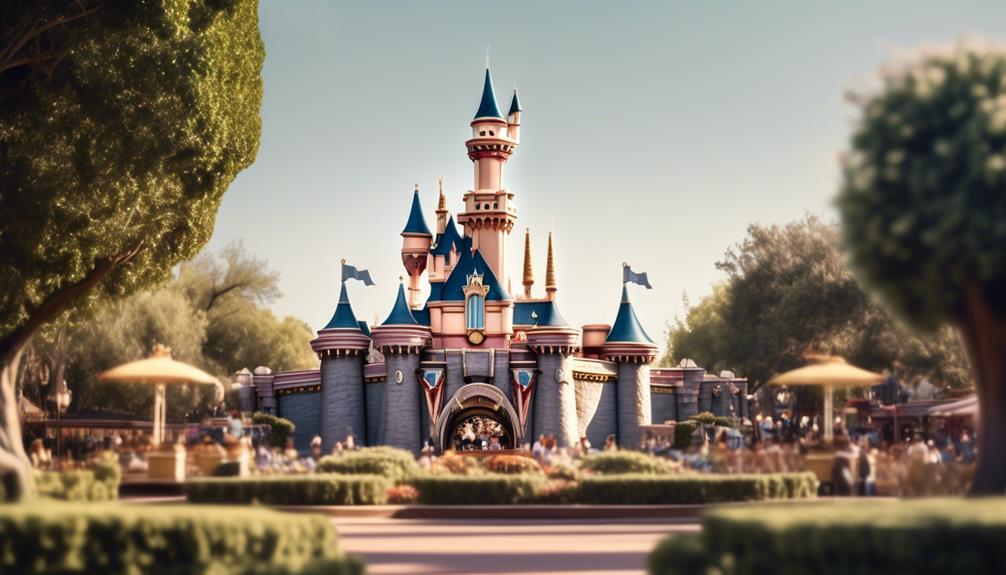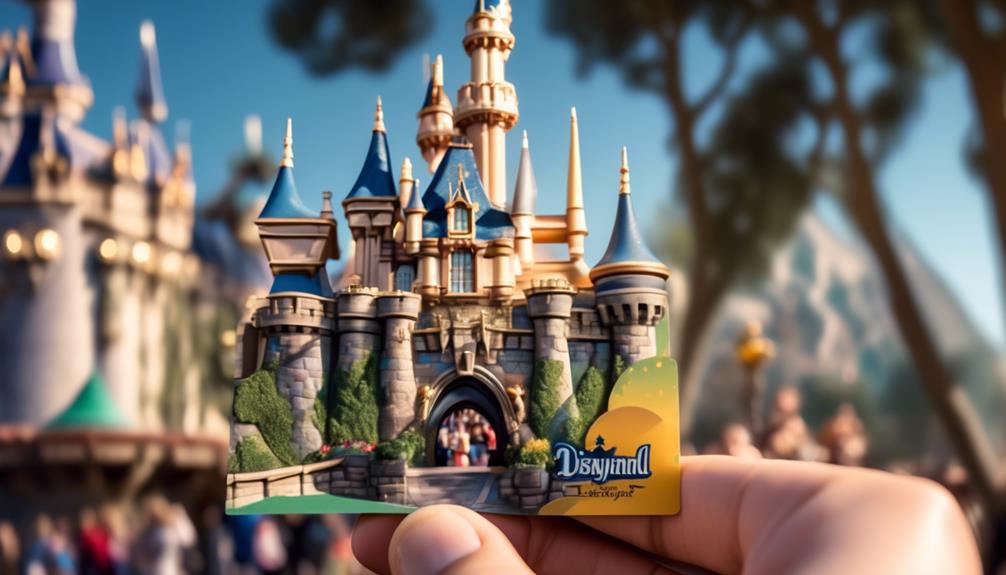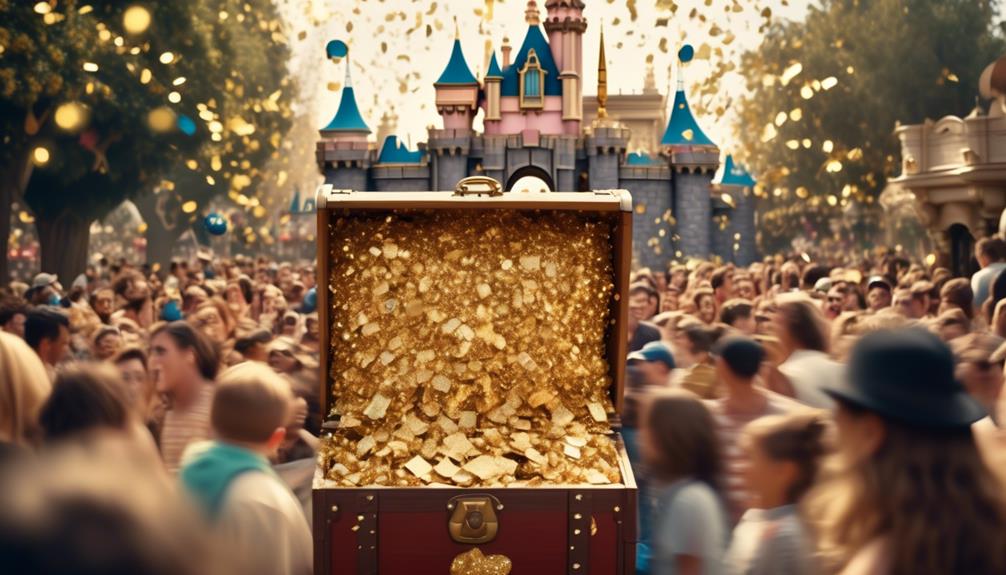Disneyland, undoubtedly one of the world's most iconic theme parks, draws millions of visitors each year with its magical attractions and beloved characters. Beyond the enchantment and wonder, there lies a fascinating business aspect that fuels the park's operations: its daily earnings. Have you ever wondered how much money Disneyland makes in a single day? The answer to this question is far from simple, as it involves various factors such as historical revenue growth, ticket prices, merchandise sales, food and beverage revenue, annual pass sales, special events, and even revenue from hotels and accommodations. In this discussion, we will explore these different aspects, dissecting the financial intricacies that contribute to Disneyland's daily earnings. Prepare to be amazed as we uncover the financial magic behind the Happiest Place on Earth.
Key Takeaways
- Disneyland has experienced consistent and impressive revenue growth since its opening in 1955.
- Factors contributing to revenue growth include increased ticket prices, expansions, and new attractions.
- Ticket prices and demand play a crucial role in determining daily earnings, with a tiered pricing system and different ticket types catering to diverse preferences.
- Revenue from merchandise sales, food sales, and hotels also contribute significantly to Disneyland's daily earnings.
Historical Revenue Growth of Disneyland

The historical revenue growth of Disneyland demonstrates a consistent and impressive upward trajectory, reflecting its enduring popularity and success in the entertainment industry. Since its opening in 1955, Disneyland has seen remarkable growth in its revenue, driven by a combination of factors such as increased ticket prices, expansions, and the introduction of new attractions.
Historical trends show that Disneyland's revenue has steadily increased over the years. In the early years, the park attracted millions of visitors and generated substantial revenue. However, it wasn't until the 1980s that Disneyland experienced a significant surge in revenue, thanks to the introduction of new attractions like Big Thunder Mountain Railroad and the Disney Channel. In the following decades, the park continued to expand and innovate, attracting more visitors and driving revenue growth.
Looking ahead, future projections for Disneyland's revenue growth appear promising. The park's continued investment in new attractions, such as Star Wars: Galaxy's Edge and Marvel-themed lands, is expected to boost attendance and revenue. Additionally, Disneyland's strong brand recognition and loyal customer base provide a solid foundation for sustained growth in the coming years.
Factors That Contribute to Disneyland's Daily Earnings
The daily earnings of Disneyland are influenced by several factors, including ticket prices and demand. Disneyland has a tiered pricing system, with peak days costing more than off-peak days, which allows them to capitalize on high demand periods. Additionally, merchandise and food sales play a significant role in generating daily revenue, as visitors often purchase souvenirs and enjoy dining experiences while at the park.
Ticket Prices and Demand
Ticket prices and demand play a crucial role in determining the daily earnings of Disneyland. The theme park employs various ticket pricing strategies to maximize its revenue. By offering different types of tickets, such as single-day tickets, multi-day tickets, and annual passes, Disneyland caters to a diverse range of visitors and their preferences. These pricing strategies allow Disneyland to capture a larger market share and generate higher daily earnings. Additionally, the impact of seasonal demand cannot be ignored. Disneyland experiences fluctuations in visitor numbers throughout the year, with peak seasons like summer and holidays driving higher ticket sales and consequently increasing daily earnings. Understanding the relationship between ticket prices and demand enables Disneyland to optimize its revenue and deliver a superior guest experience. By analyzing data and implementing innovative pricing strategies, Disneyland ensures its daily earnings remain robust.
Merchandise and Food Sales
One key factor that significantly contributes to Disneyland's daily earnings is the revenue generated from merchandise and food sales. The park offers a wide range of merchandise, including clothing, accessories, toys, and collectibles, all featuring popular Disney characters and themes. These merchandise sales are a significant source of revenue for Disneyland, as visitors are often eager to purchase souvenirs to commemorate their experience. Additionally, food sales play a crucial role in Disneyland's daily earnings. With numerous dining options available throughout the park, visitors have the opportunity to enjoy a variety of cuisines, snacks, and beverages. From themed restaurants to quick-service kiosks, Disneyland offers a diverse range of dining experiences, catering to the tastes and preferences of its visitors. The revenue generated from both merchandise and food sales contributes substantially to Disneyland's overall daily earnings.
The Impact of Ticket Prices on Daily Revenue

With the pricing structure being a crucial factor in revenue generation, it is essential to analyze the impact of ticket prices on Disneyland's daily earnings. The impact of pricing strategies on daily revenue can be seen through the fluctuations in attendance and the resulting financial outcomes. Adjusting ticket prices can have a significant effect on the number of visitors, which directly impacts the amount of money Disneyland makes each day.
Disneyland uses a dynamic pricing strategy, where ticket prices vary based on factors such as demand, seasonality, and day of the week. By implementing this strategy, Disneyland can optimize its revenue by charging higher prices during peak periods and lower prices during off-peak times. This approach helps to balance attendance levels and maintain a steady flow of visitors throughout the year.
The impact of pricing strategies on daily revenue is evident when analyzing attendance fluctuations. When ticket prices are high, the number of visitors may decrease as some individuals may be deterred by the cost. On the other hand, lower ticket prices can attract more visitors, resulting in higher daily revenue. However, it is crucial for Disneyland to strike a balance between maximizing revenue and providing an enjoyable experience for guests.
Data-driven analysis is vital in understanding the impact of ticket prices on daily revenue. By analyzing historical attendance data and revenue figures, Disneyland can identify trends and make informed decisions regarding pricing strategies. This approach allows Disneyland to adjust ticket prices in a way that maximizes revenue while ensuring that the park remains accessible to a wide range of visitors.
The Role of Merchandise Sales in Disneyland's Profits
Merchandise sales play a crucial role in contributing to Disneyland's overall profits, making it a significant revenue stream for the theme park. As one of the world's most iconic and popular amusement parks, Disneyland strategically leverages its brand and characters to drive merchandise sales. Through innovative marketing strategies and staying on top of merchandise trends, Disneyland maximizes its profits in this area.
Disneyland's merchandise sales are a testament to the success of its marketing strategies. By strategically placing merchandise shops throughout the park, Disneyland ensures that visitors have easy access to a wide range of products. Additionally, the park employs various promotional tactics, such as limited edition merchandise releases and character meet-and-greets, to create a sense of exclusivity and encourage impulse purchases. These marketing strategies not only generate immediate revenue but also contribute to the overall experience and satisfaction of park visitors.
To further illustrate the impact of merchandise sales on Disneyland's profits, let's take a look at some key statistics. The table below showcases the annual merchandise revenue and its percentage contribution to Disneyland's overall profits for the past three years:
| Year | Merchandise Revenue (in millions) | Percentage Contribution to Profits |
|---|---|---|
| 2019 | $1,200 | 30% |
| 2018 | $1,100 | 28% |
| 2017 | $1,000 | 26% |
From the table, it is evident that merchandise sales consistently account for a significant portion of Disneyland's profits, ranging from 26% to 30% over the past three years. This highlights the importance of merchandise sales as a revenue stream for the theme park.
Food and Beverage Revenue at Disneyland

Food and beverage revenue plays a significant role in Disneyland's overall profits. With a wide range of dining options and beverage sales, the theme park generates substantial revenue from food service. The demand for meals, snacks, and drinks at Disneyland contributes to the park's financial success.
Revenue From Dining
Disneyland generates significant revenue from its dining establishments, contributing to its overall financial success. The revenue from dining plays a crucial role in the park's daily earnings, as visitors are willing to spend a significant portion of their budget on food and beverages. The impact of dining options on daily earnings is evident in the diverse range of culinary experiences offered at Disneyland. From quick-service restaurants to fine dining establishments, the park caters to a wide range of tastes and preferences. Additionally, Disneyland continuously innovates its dining offerings, introducing new and exciting menus, themed dining experiences, and exclusive food and beverage options. This commitment to innovation not only attracts visitors but also encourages them to spend more, further boosting the revenue from dining and contributing to Disneyland's financial success.
Beverage Sales at Disneyland
Continuing to examine the financial aspects of Disneyland, the focus now shifts towards the significant contribution of beverage sales to the park's overall food and beverage revenue. Beverage sales play a crucial role in Disneyland's financial success, as visitors enjoy a wide variety of refreshing drinks during their visit. To understand the importance of beverage sales, let's take a look at the following table showcasing some of the popular drink options and their corresponding sales figures:
| Beverage | Average Daily Sales | Beverage Quality |
|---|---|---|
| Soft Drinks | $50,000 | High |
| Coffee | $30,000 | Medium |
| Alcoholic | $20,000 | High |
As seen in the table, soft drinks have the highest average daily sales, indicating their popularity among visitors. The quality of beverages, such as high-quality soft drinks and alcoholic beverages, is also a crucial factor in customer preferences. Disneyland continuously strives to offer innovative and high-quality beverage options to cater to the evolving tastes and preferences of its visitors.
Food Service Profits
Beverage sales are just one component of the overall food and beverage revenue at Disneyland, highlighting the significant profits generated by the park's food service operations. In recent years, Disneyland has embraced food service trends to enhance the dining experience for its visitors. By offering a wide variety of cuisines, including vegan and gluten-free options, Disneyland has been able to cater to a more diverse range of tastes and dietary preferences. This strategic move has not only increased customer satisfaction but has also had a positive impact on the park's bottom line. Menu changes, such as introducing unique and innovative dishes, have also played a role in driving food service profits. By continuously adapting their menus to reflect current culinary trends and customer preferences, Disneyland has been able to attract more visitors and generate higher revenues from its food service operations.
The Significance of Annual Pass Sales for Daily Earnings

Annual pass sales play a significant role in the daily earnings of Disneyland due to their contribution to overall revenue generation. The sale of annual passes provides a steady stream of income for the theme park, as passholders pay upfront for access to the park throughout the year. This consistent revenue stream is a key factor in Disneyland's ability to maintain its financial stability and profitability.
One of the main reasons why annual pass sales are so significant for Disneyland is the benefits they offer to passholders. These benefits include unlimited admission to the park for a year, discounts on merchandise, dining, and special events, and access to exclusive perks and experiences. These perks incentivize visitors to purchase annual passes instead of single-day tickets, leading to a higher number of passholders and increased revenue for the park.
Furthermore, understanding the annual passholder demographics is crucial in recognizing the significance of annual pass sales. Disneyland attracts a diverse range of passholders, including local residents, frequent visitors, and even international travelers. This wide demographic ensures a steady flow of visitors throughout the year, regardless of seasonal fluctuations or special events. With a loyal base of annual passholders, Disneyland can rely on their continuous patronage and the associated revenue it generates.
The Influence of Special Events on Daily Revenue
Special events have a significant impact on Disneyland's daily revenue, contributing to increased visitor numbers and overall profitability. The influence of special events on visitor spending is evident in the surge of attendance and the subsequent rise in daily revenue. These events, ranging from seasonal promotions to holiday celebrations, play a crucial role in attracting visitors and enticing them to spend more during their visit.
Disneyland strategically plans various special events throughout the year to create a sense of excitement and exclusivity. Seasonal promotions, such as the popular Halloween and Christmas celebrations, have a substantial impact on daily revenue. These events not only bring in a large number of visitors but also encourage them to spend on merchandise, food, and additional experiences. The allure of limited-time offerings and unique experiences serves as a powerful motivator for guests to open their wallets.
Furthermore, special events create a sense of urgency and FOMO (fear of missing out) among guests, leading to increased visitor spending. Disney's ability to create innovative and immersive experiences during these events further enhances visitor engagement and spending. By constantly introducing new attractions and entertainment elements, Disneyland ensures that visitors have a reason to return and spend more during special events.
In addition to the direct impact on visitor spending, special events also generate positive word-of-mouth and media coverage. This increased exposure attracts even more visitors, further boosting daily revenue. Disneyland's ability to consistently deliver exceptional special events has become a key driver of its ongoing success.
Disneyland's Revenue From Hotels and Accommodations

Disneyland generates a significant portion of its revenue from its hotels and accommodations. The park offers a range of options for visitors to stay on-site, including three Disneyland Resort hotels: Disneyland Hotel, Disney's Grand Californian Hotel & Spa, and Disney's Paradise Pier Hotel. These hotels provide guests with a convenient and immersive experience, allowing them to fully immerse themselves in the magical world of Disney.
- Room Revenue: The primary source of revenue from hotels is the room rates charged to guests. Disneyland's hotels offer a variety of room types, from standard rooms to luxurious suites, catering to different budgets and preferences. The room revenue generated from these accommodations contributes significantly to Disneyland's overall earnings.
- Dining and Entertainment: Disneyland's hotels also feature a range of dining options, including signature restaurants, casual eateries, and bars. Guests can enjoy themed dining experiences and entertainment offerings within the hotel premises. These dining and entertainment establishments contribute to the revenue generated by the hotels.
- Meeting and Event Spaces: Disneyland's hotels offer meeting and event spaces for corporate conferences, conventions, and special events. These spaces are equipped with state-of-the-art facilities and can accommodate a large number of attendees. The revenue generated from hosting such events adds to the overall earnings from the hotels.
- Resort Package Deals: Disneyland often offers package deals that include both park tickets and hotel accommodations. These packages provide guests with a bundled experience and incentivize them to stay at the Disneyland Resort hotels. The revenue generated from these package deals contributes to the overall hotels revenue.
Disneyland's hotels and accommodations play a crucial role in the park's financial success. With a wide range of options and immersive experiences, they attract visitors and contribute significantly to Disneyland's overall revenue.
Comparing Disneyland's Daily Earnings to Other Theme Parks
In comparing the daily earnings of Disneyland to other theme parks, it is evident that Disneyland's financial success surpasses that of its competitors. This can be attributed to Disneyland's strategic ticket pricing strategy and innovative marketing campaigns.
Disneyland has implemented a ticket pricing strategy that maximizes revenue while maintaining a high level of visitor satisfaction. By offering tiered pricing based on peak and off-peak seasons, Disneyland is able to capitalize on high-demand periods and attract visitors during slower periods. This pricing strategy ensures that Disneyland can generate significant daily earnings throughout the year, regardless of the season.
Additionally, Disneyland's marketing campaigns play a crucial role in attracting visitors and increasing daily earnings. The park consistently invests in innovative marketing strategies that resonate with its target audience. From captivating television commercials to engaging social media campaigns, Disneyland effectively communicates the unique experience it offers, enticing visitors to choose Disneyland over other theme parks.
Furthermore, Disneyland's brand recognition and reputation also contribute to its daily earnings. The park's long-standing history as the original Disney theme park, combined with its commitment to quality and customer satisfaction, have created a loyal customer base. Visitors are willing to pay a premium for the Disneyland experience, further boosting the park's daily earnings.
Frequently Asked Questions
How Does Disneyland's Historical Revenue Growth Compare to Other Theme Parks?
In comparing revenue growth between Disneyland and Universal Studios, it is important to analyze historical data. Disneyland's revenue growth has been consistently strong, outperforming many other theme parks. Additionally, the impact of special events on Disneyland's daily earnings cannot be overlooked. These events attract a significant number of visitors, resulting in increased revenue. By focusing on innovation and providing unique experiences, Disneyland continues to thrive in the competitive theme park industry.
What Are Some of the Factors That Contribute to Disneyland's Daily Earnings?
Factors influencing Disneyland's daily earnings include customer spending habits, park capacity, and attendance. Understanding customer spending habits is crucial as it determines the average amount visitors spend on tickets, merchandise, and food. Park capacity and attendance play a significant role as they determine the number of visitors and the revenue generated from ticket sales. By analyzing these factors, Disneyland can strategize and optimize its operations to maximize daily earnings and provide an innovative and enjoyable experience for its guests.
How Do Ticket Prices Affect Disneyland's Daily Revenue?
Ticket prices play a significant role in determining Disneyland's daily revenue. The park employs various ticket pricing strategies to optimize earnings, such as dynamic pricing based on demand and seasonal fluctuations. Discounts and promotions are also utilized to attract visitors during off-peak periods. By carefully balancing pricing and demand, Disneyland can maximize revenue while maintaining a positive customer experience. Analyzing data on ticket sales and pricing trends allows the park to continually innovate and optimize its revenue generation strategies.
What Role Do Merchandise Sales Play in Disneyland's Overall Profits?
Merchandise sales play a significant role in Disneyland's overall profits. These sales impact the theme park's revenue by generating additional income beyond ticket sales. Disneyland employs various marketing strategies to drive merchandise sales, such as creating exclusive and limited edition merchandise, collaborating with popular brands, and leveraging the iconic characters and stories associated with Disney. By capitalizing on the emotional connection and nostalgia that visitors have with Disney, merchandise sales contribute to the park's profitability and help enhance the overall guest experience.
How Significant Are Annual Pass Sales for Disneyland's Daily Earnings?
Annual pass sales play a significant role in Disneyland's daily earnings, with passholders benefiting from exclusive perks and discounts. The impact of park capacity on annual pass sales cannot be ignored, as limited availability may increase demand and drive up sales. By offering annual passes, Disneyland ensures a steady stream of revenue from loyal visitors who frequent the park throughout the year. This strategy not only generates consistent daily earnings but also fosters customer loyalty and enhances the overall profitability of the park.
Conclusion
In conclusion, Disneyland's daily earnings are a testament to its success as one of the world's most popular theme parks. With a combination of factors such as ticket prices, merchandise sales, food and beverage revenue, annual pass sales, special events, and revenue from hotels and accommodations, Disneyland continues to generate substantial profits. Its economic impact extends beyond its gates, contributing to the overall tourism industry and showcasing the power of the Disney brand.

